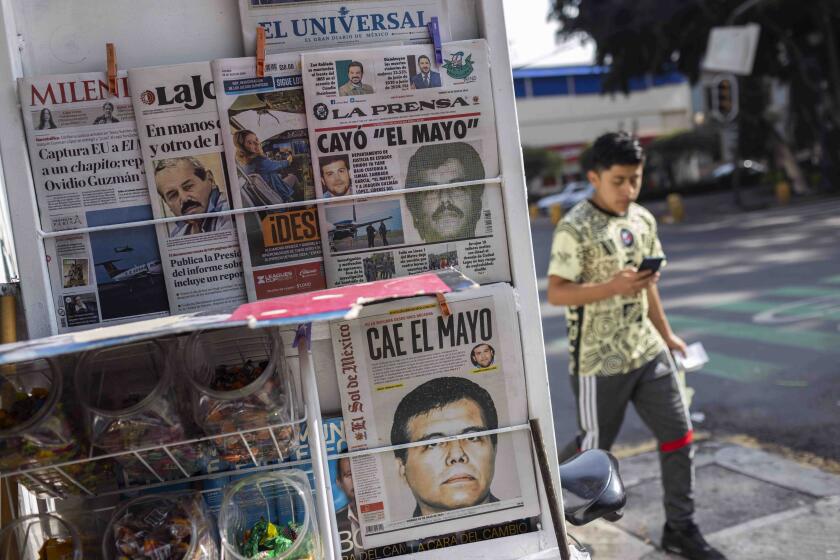Life of a Terrorist: Seeking, and Finding, His Jihad
Zacarias Moussaoui was an easy mark. Young and nearly broke, sleeping in a London shelter, he was ashamed of his past and uncertain of his future. And each day, when he went to the mosque in Brixton, he would run a gantlet of Islamic extremists.
Eventually, they snared him.
And the story of how a disaffected, down-and-almost-out young Muslim became a self-described member of the 9/11 plot offers chilling insights into the way Al Qaeda trolls for recruits and trains them to become suicidal zealots, willing to kill themselves to kill others.
Had Moussaoui not surrendered to the spell of the radicals, his life might have been different. After all, he had broken away from his impoverished childhood in France, as well as his violent, alcoholic father. He had made it to London. He was smart; he earned a master’s degree in business.
But that was the road not taken.
At the Brixton mosque, he began wearing military camouflage and black boots. He criticized fellow Muslims as too soft. “Where’s the jihad?” he kept asking. “Where’s the jihad?”
From there, joining Islamist guerrillas in Chechnya was not a big step. Neither was signing up for Al Qaeda training camps in Afghanistan. Or flight school in America.
Moussaoui found his war.
Last year, he pleaded guilty to being involved with the Sept. 11, 2001, plot. This week, a federal jury in Alexandria, Va., will begin deliberating on what the legal consequences of his involvement with Al Qaeda should be -- a death row cell or life in prison without the possibility of parole.
But for government and other analysts who focus on trying to understand how seemingly ordinary young men become terrorists or would-be terrorists, testimony and documents in the sentencing trial offered valuable details about the path men such as Moussaoui have traveled.
Paul R. Martin, an expert on cults, said Moussaoui represented the classic case of a vulnerable young man brainwashed by Islamic radicals in London during the mid-1990s. “They swept him away,” Martin told the jury last week.
Martin said that French Moroccans such as Moussaoui living in Western Europe “just didn’t feel like they fit in. They were sort of on the fringes. So when some of them came into contact with these radical elements, they felt for the first time that, ‘Wow, I belong. This is my home.’ ”
Other new evidence came from Mohammed al-Qahtani, the so-called 20th 9/11 hijacker. In a summary of what he has told U.S. interrogators at the prison at Guantanamo Bay, Cuba, Al-Qahtani described how Al Qaeda isolated men like him and Moussaoui and transformed them into automatons for jihad. They were herded together at training camps, Al-Qahtani said, assigned to group tents, cut off from the outside world. One man ruled their life: Osama bin Laden, whom they called “the big boss.”
Also, a new CIA report was read to jurors that further outlined Al Qaeda’s “brainwashing techniques.” It even told of one initiate who feared for his life and with some perseverance had made it out of the camps.
Moussaoui arrived in England around 1995. He was in his late 20s and enrolled in business school. Fellow student Nil Plant recalled him as friendly and ambitious. “But he wasn’t a proper Arab or a French boy either. He was sort of stuck in between, belonging to nowhere. He had a lot going for him, but nowhere to go.”
Abdul Haqq Baker, the imam at the Brixton mosque, testified that Moussaoui “came in eager, quick to learn.” But outside the front doors were radicals passing out leaflets and warning that Baker and other mosque leaders were too soft. They said the Middle East was aflame and yet the mosque leaders sat idly by.
The leaflets announced upcoming militant study groups. The titles included “Victory to Muslims!” and “Why Muslims Are Weak.” The radicals showed films of young Muslim boys castrated in Bosnia, their genitals displayed on trays. They derided U.N. troops as “blue hats,” and said they used Muslim women as “pleasure girls.” Moussaoui was intrigued and started attending the radicals’ study circles.
“His friendly demeanor changed,” Baker said. He erupted into tirades; asked to calm down, Moussaoui shouted epithets. “You could see the disdain in his face,” Baker said.
By now, according to Martin, the extremists controlled Moussaoui: “Probably, at that point, he felt like he owed them his life.”
Moussaoui went off to Chechnya. He turned up at the Al Qaeda camps in Afghanistan, where he drove young recruits from the airport and back. He trained in explosives and pledged bayat -- total loyalty -- to Bin Laden.
The CIA report said the camps “provided the isolation and psychological atmosphere necessary to support classic brainwashing techniques.” The goal was to turn recruits into “committed operatives who could be trusted to live for several years in the West and still carry out their mission.”
Travel to Afghanistan was crucial; Al Qaeda wanted its young fighters immersed in the “pure Islamic state.” Additional pressures were applied to prevent “backsliding,” especially to keep a “second wave” of recruits in line for a planned follow-up attack after Sept. 11.
Moussaoui, Al-Qahtani and many of the 9/11 hijackers were at the Afghanistan camps at about the same time. Al-Qahtani described how the system worked at two camps.
The first had a rigorous schedule, where all students prayed together, rarely leaving one another’s sights. Bin Laden frequently visited. He gave “sermons, recommendations and advice regarding jihad, the struggle of Islam and bayat,” Al-Qahtani said. Recruits swore allegiance to the “Prince of Jihad.”
Al-Qahtani moved to an advanced training camp near the airport at Kandahar, Afghanistan, at a place called Tarnak Farms. They practiced breaching doors and waging close-quarter combat. They were taught explosives “in case they ever needed to use them.”
Al-Qahtani was selected as the 20th hijacker for Sept. 11. But he was turned away at the Orlando, Fla., airport in August 2001 when he drew the suspicion of authorities. Moussaoui by then had been in this country for eight months. He said he was sent by Bin Laden to join the Sept. 11 team. He first took flight training in Oklahoma City.
According to FBI memos, Suhaib Webb, the imam at the Islamic Society of Greater Oklahoma City, said Moussaoui complained that mosque members were too complacent.
Moussaoui took one member of the mosque, Hussein al-Attas, under his wing. Webb believed that “Al-Attas was probably brainwashed” by Moussaoui into planning a trip to Pakistan for jihad. Instead, Moussaoui was arrested taking jet simulation lessons after he and Al-Attas drove to Minneapolis.
Moussaoui believes that someday he will be set free. But the truth appears far different. As far as Bin Laden’s lieutenants are concerned, evidence presented near the end of the trial suggested, the Brixton recruit was used up -- expendable.
More to Read
Sign up for Essential California
The most important California stories and recommendations in your inbox every morning.
You may occasionally receive promotional content from the Los Angeles Times.









